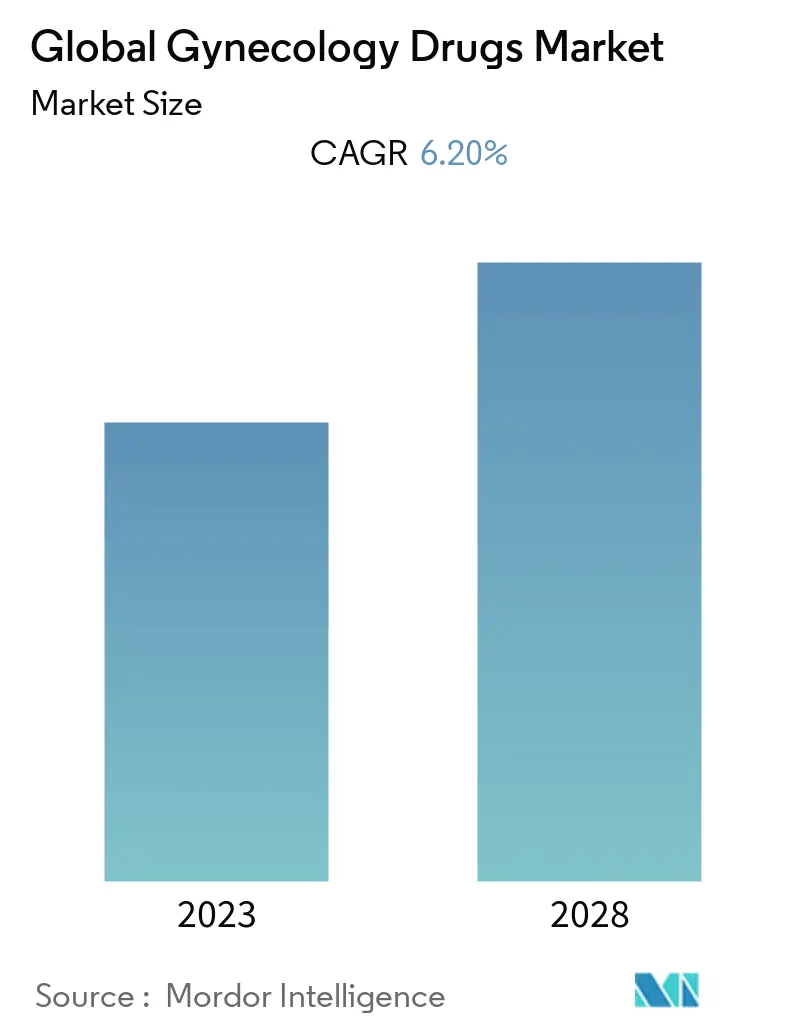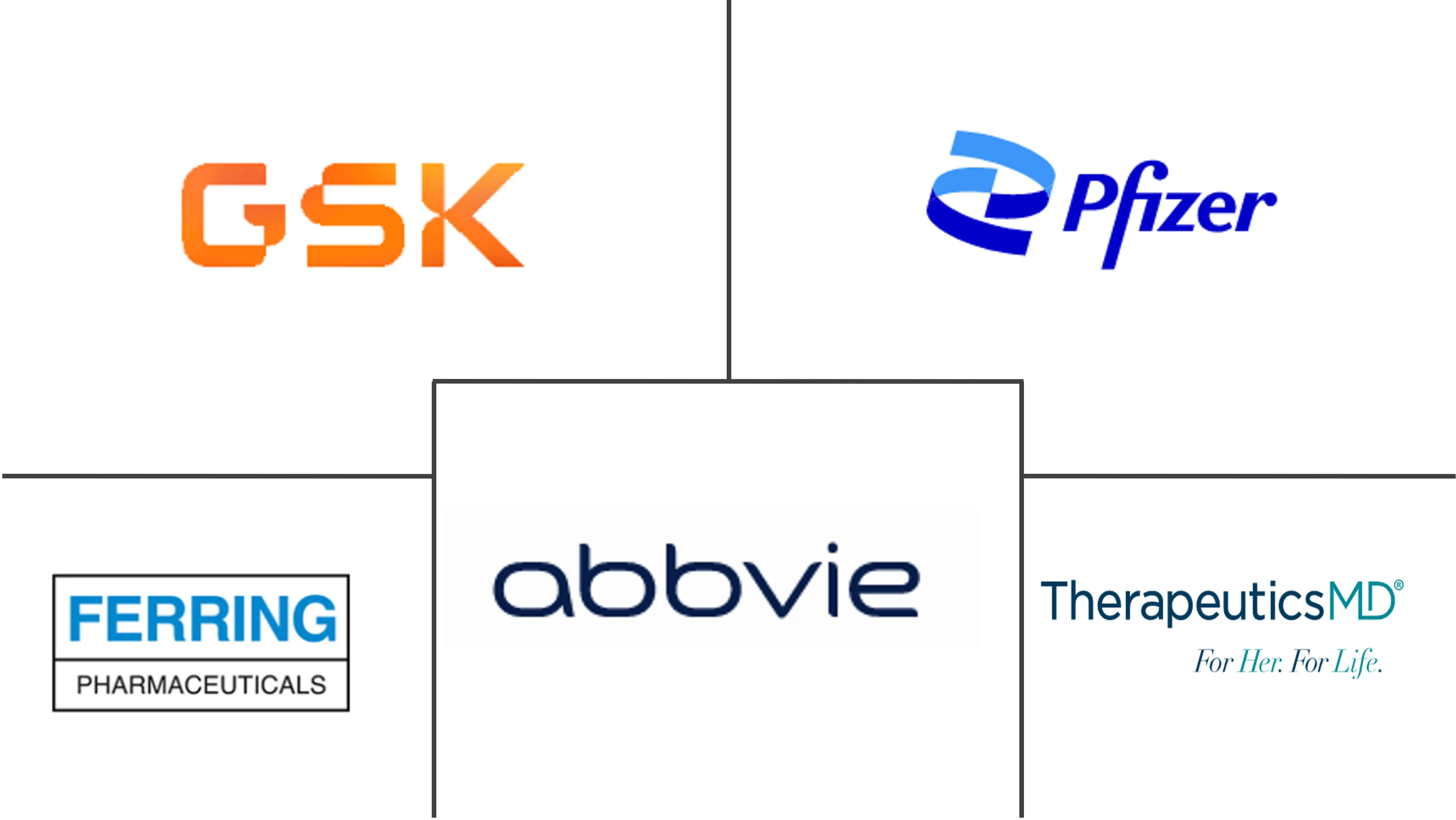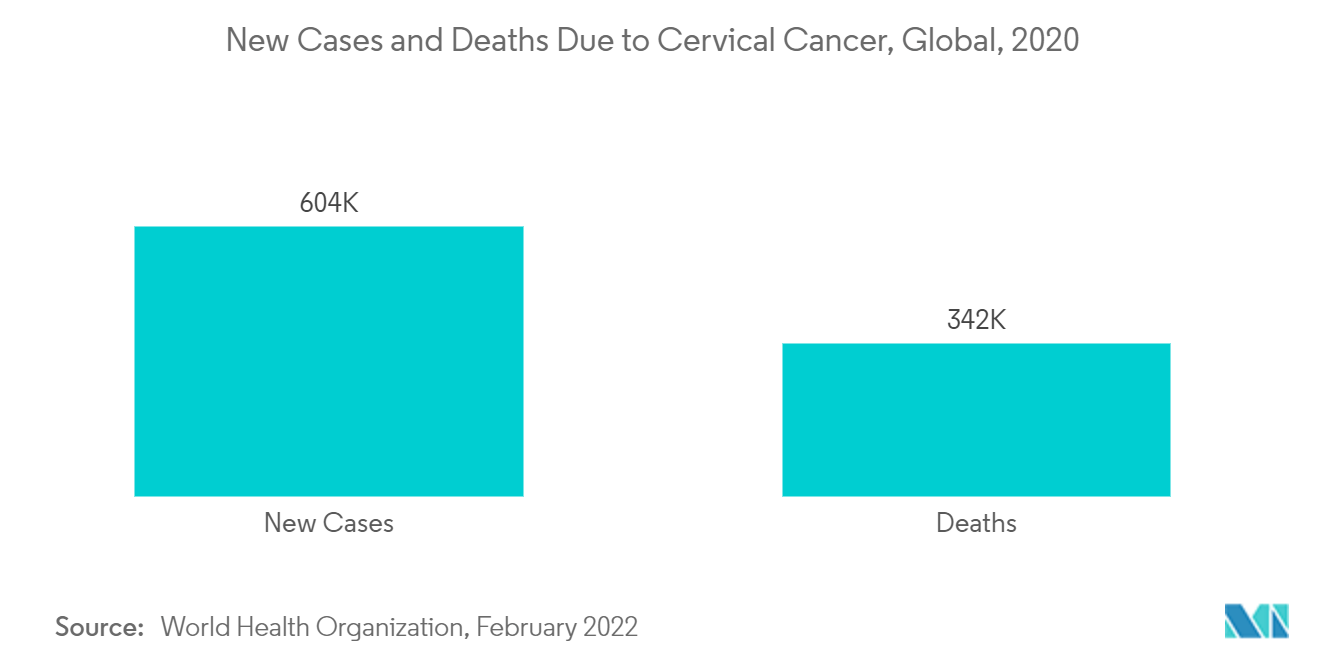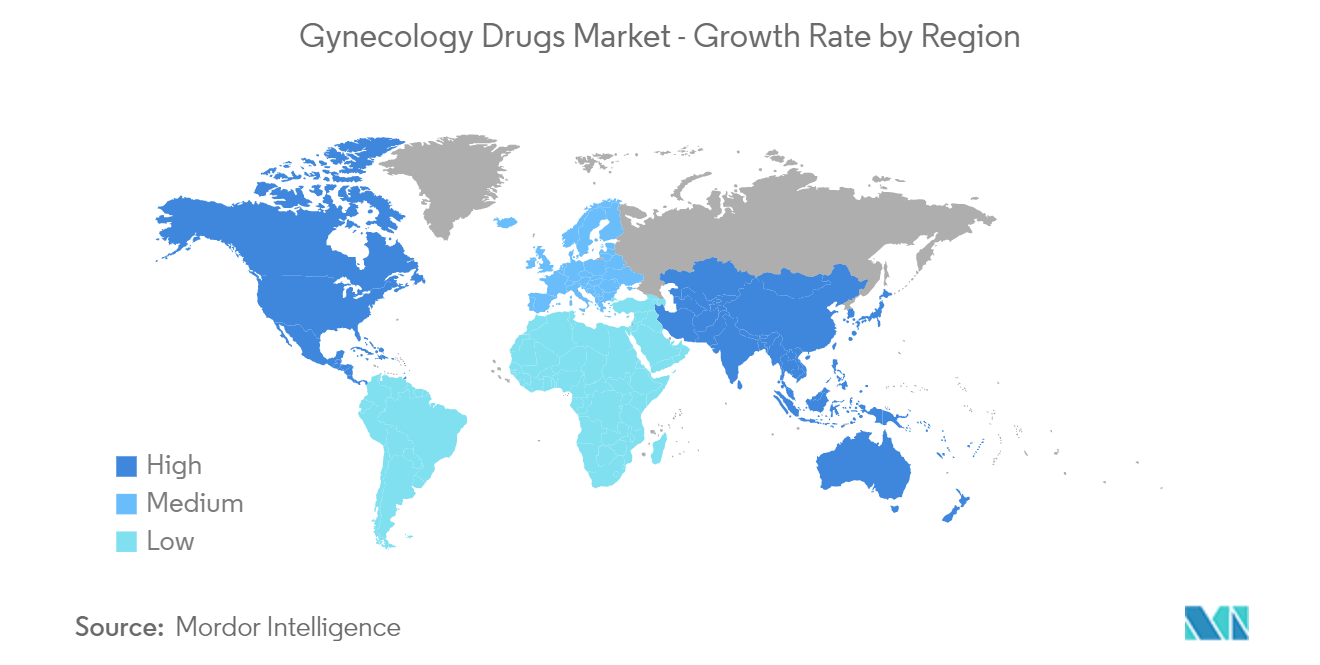Gynecology Drugs Market Size

| Study Period | 2018 - 2028 |
| Base Year For Estimation | 2021 |
| Forecast Data Period | 2024 - 2028 |
| CAGR | 6.20 % |
| Fastest Growing Market | Asia Pacific |
| Largest Market | North America |
Major Players
*Disclaimer: Major Players sorted in no particular order |
Need a report that reflects how COVID-19 has impacted this market and its growth?
Gynecology Drugs Market Analysis
The gynecology drugs market is expected to register a CAGR of 6.2% over the forecast period.
The outbreak of the COVID-19 pandemic has pushed the pharmaceutical industry into action, with a race to develop both therapeutic and preventive drugs. Exponentially increasing cases of the coronavirus worldwide are leading to the need for the development of novel treatments, with several clinical trials underway. The COVID-19 pandemic has considerably impacted the management of patients with gynecologic cancers. Many centers have reduced access to routine visits to avoid crowded waiting areas especially to reduce the infection risk for oncologic patients. Cancer patients were a vulnerable group of patients with a high risk of COVID-19 infection, and infected patients may suffer from more deteriorating conditions and unlikely outcomes. As per the study titled, "Gynecologic cancer surveillance in the era of SARS-CoV-2 (COVID-19)" in 2021, the multidisciplinary gynecologic cancer team at the Hospital del Mar reconsidered patterns of surveillance to propose telemedicine-based follow-up strategies for cervical, endometrial, and ovarian cancer patients. In addition, as per the study titled, "Management of Gynecologic Cancer During COVID-19 Pandemic: South Asian Perspective" published in January 2022, the management of gynecological cancers has suffered during the pandemic, partly due to lockdown and partly due to directing resources to manage COVID-19 patients. It also stated that modification of gynecological cancer management during the pandemic was recommended. Therefore such instances indicate that the market witnessed slow growth during the pandemic. However, with the ease of restrictions and lockdowns and declining cases of COVID-19, the market is expected to witness considerable growth over the forecast period.
The rising incidence of various gynecological cancer is projected to be continued in the future which is likely to fuel the demand for efficient treatment driving the global gynecological drugs market over the forecast period. According to the data published by the National Cancer Institute in January 2022, the estimated number of new cervical cancer cases in 2022 is around 14,100 in the United States which is around 0.7% up from previous years of all new cancer cases. It also reported that around 4,280 women will die from cervical cancer in 2022. Similarly, as per the report published by the American Cancer Society in January 2022, around 19,880 women are expected to receive a new diagnosis of ovarian cancer and around 12,810 women are expected to die from ovarian cancer in the United States in 2022. Therefore, such a high prevalence of gynecology cancers is expected to fuel the demand for gynecology drugs thereby, propelling the market growth.
However, the high cost and stringent regulatory framework that delays the approval of products are likely to impede market growth over the forecast period.
Gynecology Drugs Market Trends
This section covers the major market trends shaping the Gynecology Drugs Market according to our research experts:
Non-hormonal Therapy Segment is Expected to Witness High Growth Over the Forecast Period
The non-hormonal therapy segment is expected to dominate the industry over the forecast period. The lucrative growth of the segment can be attributed to the rise in the adoption of these products due to proven efficiency in the treatment, rapid advancements in new product development with reduced side effects coupled with the availability of a wide range of marketed products. Furthermore, the disadvantages of hormonal therapy such as the risk of breast cancer and other complications associated with these products are expected to foster the demand for non-hormonal products during the forecast period.
Various studies are being conducted to measure the effectiveness and advantages of non-hormonal therapy. For instance, according to the study titled, "Effectiveness of NLRP3 Inhibitor as a Non-Hormonal Treatment for ovarian endometriosis" published in March 2022, NLRP3/IL-1β is involved in the pathogenesis of endometriosis and the NLRP3 inhibitor may be useful for suppressing ovarian endometriosis and improving the function of ovaries with endometriosis. In addition, increasing clinical trials for launching new non-hormonal therapy drugs for various symptoms are also surging the segment growth. For instance, in October 2021, Bayer commenced the Phase III clinical development program OASIS, which aims to evaluate the efficacy and safety of elinzanetant for the treatment of vasomotor symptoms during menopause.
Therefore, increasing studies on non-hormonal therapy and clinical trials are expected to increase awareness of the application of non-hormonal therapy in treating gynecological cancers. Hence, significant segment growth is anticipated over the forecast period.

North America is Expected to Dominate the Gynecology Drugs Market
North America is expected to dominate the global gynecology drugs market over the forecast period. This dominance is mainly owing to rising incidences of breast cancer, menopausal disorders, polycystic ovary syndrome, and others due to busy lifestyles and the rise in stress among the women in the region. For instance, as per the report published by the Canadian Cancer Society in May 2022, it is estimated that around 1,450 Canadian women will be diagnosed with cervical cancer in 2022 and around 380 will die from cervical cancer. Moreover, the availability of advanced healthcare infrastructure, an increase in government expenditure for women's healthcare awareness, the geriatric women population along with early product launches with enhanced quality in the region are expected to contribute to the market growth over the forecast period.
Key product launches, high concentration of market players or manufacturer's presence, and acquisition & partnerships among major players, and the high prevalence of gynecological cancers in the United States are some of the factors driving the growth of the gynecology drugs market in the region. For instance, as per the report published by the American Cancer Society in January 2022, breast cancer is the most common cancer in women in the United States, which is about 30.0% or 1 out of 3 of all new female cancers each year. Such high prevalence is anticipated to surge the demand for gynecology drugs, thereby propelling the market growth in the United States over the forecast period.

Gynecology Drugs Market News
- In September 2022, Lynparza received approval in China as the first line of maintenance treatment with bevacizumab for homologous recombination deficiency (HRD)-positive advanced ovarian cancer.
- In May 2021, Myovant Sciences and Pfizer Inc. received approval from the United States Food and Drug Administration (FDA) for MYFEMBREE, the first once-daily treatment for the management of heavy menstrual bleeding associated with uterine fibroids in premenopausal women, with a treatment duration of up to 24 months.
Gynecology Drugs Market Report - Table of Contents
1. INTRODUCTION
1.1 Study Assumptions and Market Definition
1.2 Scope of the Study
2. RESEARCH METHODOLOGY
3. EXECUTIVE SUMMARY
4. MARKET DYNAMICS
4.1 Market Overview
4.2 Market Drivers
4.2.1 Increasing Global Burden of Gynecological Diseases
4.2.2 Rise in Healthcare Awareness Along with Increasing Ageing Female Population
4.3 Market Restraints
4.3.1 High Cost and Stringent Regulatory Framework that Delays the Approval of the Drugs
4.4 Porter's Five Force Analysis
4.4.1 Threat of New Entrants
4.4.2 Bargaining Power of Buyers/Consumers
4.4.3 Bargaining Power of Suppliers
4.4.4 Threat of Substitute Products
4.4.5 Intensity of Competitive Rivalry
5. MARKET SEGMENTATION (Market Size by Value – USD Million)
5.1 By Therapeutics
5.1.1 Hormonal Therapy
5.1.2 Non-hormonal Therapy
5.2 By Indication
5.2.1 Gynecology Cancers
5.2.2 Menopausal Disorder
5.2.3 Polycystic Ovary Syndrome
5.2.4 Contraception
5.2.5 Others
5.3 By Distribution Channel
5.3.1 Hospital Pharmacies
5.3.2 Retail Pharmacies
5.3.3 Online Pharmacies
5.4 Geography
5.4.1 North America
5.4.1.1 United States
5.4.1.2 Canada
5.4.1.3 Mexico
5.4.2 Europe
5.4.2.1 Germany
5.4.2.2 United Kingdom
5.4.2.3 France
5.4.2.4 Italy
5.4.2.5 Spain
5.4.2.6 Rest of Europe
5.4.3 Asia-Pacific
5.4.3.1 China
5.4.3.2 Japan
5.4.3.3 India
5.4.3.4 Australia
5.4.3.5 South Korea
5.4.3.6 Rest of Asia-Pacific
5.4.4 Middle-East and Africa
5.4.4.1 GCC
5.4.4.2 South Africa
5.4.4.3 Rest of Middle-East and Africa
5.4.5 South America
5.4.5.1 Brazil
5.4.5.2 Argentina
5.4.5.3 Rest of South America
6. COMPETITIVE LANDSCAPE
6.1 Company Profiles
6.1.1 Pfizer Inc.
6.1.2 AbbVie Inc.
6.1.3 TherapeuticsMD Inc.
6.1.4 Ferring Holding SA
6.1.5 Lupin Pharmaceuticals Inc
6.1.6 Johnson & Johnson
6.1.7 Eli Lilly and Company
6.1.8 Bayer AG
6.1.9 Abbott Laboratories Ltd.
6.1.10 AstraZeneca
- *List Not Exhaustive
7. MARKET OPPORTUNITIES AND FUTURE TRENDS
Gynecology Drugs Industry Segmentation
Gynecological drug medications are used to treat ailments related to the female reproductive system. A major shift in the lifestyles of women led to a rise in the prevalence of gynecological disorders affecting the functioning of the uterus, ovaries, and appendages. The Gynecology Drugs Market is segmented by Therapeutics (Hormonal Therapy and Non-hormonal Therapy), by Indication (Gynecology Cancers, Menopausal Disorder, Polycystic Ovary Syndrome, Contraception, and Others), by Distribution Channel (Hospital Pharmacies, Retail Pharmacies, and Online Pharmacies), and Geography (North America, Europe, Asia-Pacific, Middle East, and Africa, and South America). The market report also covers the estimated market sizes and trends for 17 different countries across major regions, globally. The report offers the value (in USD million) for the above segments.
| By Therapeutics | |
| Hormonal Therapy | |
| Non-hormonal Therapy |
| By Indication | |
| Gynecology Cancers | |
| Menopausal Disorder | |
| Polycystic Ovary Syndrome | |
| Contraception | |
| Others |
| By Distribution Channel | |
| Hospital Pharmacies | |
| Retail Pharmacies | |
| Online Pharmacies |
| Geography | ||||||||
| ||||||||
| ||||||||
| ||||||||
| ||||||||
|
Gynecology Drugs Market Research FAQs
What is the current Global Gynecology Drugs Market size?
The Global Gynecology Drugs Market is projected to register a CAGR of 6.2% during the forecast period (2023-2028).
Which is the fastest growing region in Global Gynecology Drugs Market?
Asia Pacific is estimated to grow at the highest CAGR over the forecast period (2023-2028).
Which region has the biggest share in Global Gynecology Drugs Market?
In 2023, the North America accounts for the largest market share in the Global Gynecology Drugs Market.
Global Gynecology Drugs Industry Report
Statistics for the 2023 Global Gynecology Drugs market share, size and revenue growth rate, created by Mordor Intelligence™ Industry Reports. Global Gynecology Drugs analysis includes a market forecast outlook to 2028 and historical overview. Get a sample of this industry analysis as a free report PDF download.
